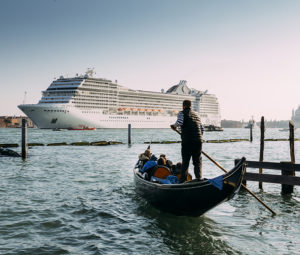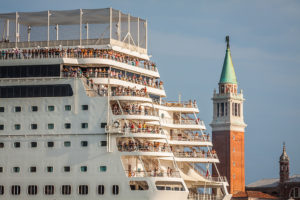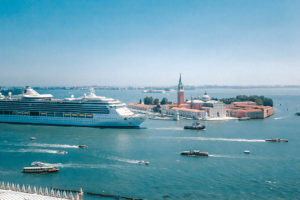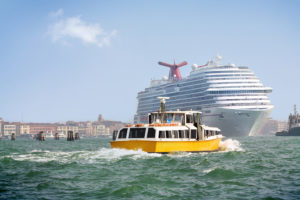The unique history of Venice has been embroidered with intrigue, romance, art, music, and politics for over 900 years. The serene city shimmers where grey-blue waters roll in from the Adriatic and where it’s 118 islands have stood like a sentinel as foreign ships carried silks, spices, jewels, and other treasures over the centuries.
Today the serenity is broken by towering mega-cruise ships carrying tourists that swarm the piazzas and narrow streets, compromising the city’s fragile infrastructure. Many locals feel that the city’s maintenance, soaring costs of living, and loss of quality of life may exceed the value of tourist revenues that flow into the coffers annually.
The gleaming white cruise ships, some soaring twelve stories high, not only threaten fragile ecosystems, cause pollution, and churn up narrow waterways but the millions of tourists put a heavy strain on the city’s services.
Venice, comprised of six districts called “Sestieri,” is spread over a 3.5 mile area, with each district being surrounded by canals connected by narrow foot bridges. Most of the city’s surrounding areas often remain deserted while the tourists crowd the hotspots around the Piazza San Marco. Many of the finest shops never benefit from the visitors even though their own rents and costs of living soar, and even restaurant owners have stated that they don’t benefit much from day-trippers as they often eat on board or snack al fresco in the piazza.
Although thousands of tourists pour into the city daily, most sleep on board and the hotels don’t reap the benefits. The Cipriani, Gritti Palace, and Bauer charge about $550+ per night and are also finding stiff competition in the Airbnb rentals that help the private homeowners retain their properties.
The locals have started to revolt against the onslaught of huge crowds that clog the streets and disrupt daily living. Last summer over 2,000 residents marched from the Arsenale along the Riva degli Sciavoni to demonstrate to government officials that they have had enough of the massive tourism, now estimated to be about 25 million per year.
The movement “Mi no vado via” (I am not going away) reflected the fact that Venetians are literally being forced to move from their homes to the mainland because rents and services have priced them out of their hometown and their lifestyles cannot be sustained. “Venice is vanishing before our eyes and the soul of Venice is dying,” a marcher lamented.
The Drawing Room of Europe
Venice is no stranger to visitors arriving from the sea. For centuries, the city was the largest shipbuilding port in the entire world and artisans and merchants from the Middle East and Mediterranean Basin traded there. In 1797 when Emperor Napoleon disembarked on the Mola Quay, and upon viewing the spacious Piazza San Marco proclaimed, “This is the drawing room of Europe,” then proceeded to loot its priceless treasures.
For centuries the wealthiest merchants lived along the meandering “S” shaped Canal Grande in palaces that necklace the banks in elaborate arabesque, baroque, and rococo architecture. Most buildings in Venice are supported by oak and alder pilings, some of which have sunk into the mud about half a foot in depths as shallow as sixteen feet, and maintenance is ongoing.
Today the population of Venice has dwindled to about 50,000 residents—about half of what it was in the 1980s. Many days the visitors can exceed the native population by double with between 35,000 to 60,000 tourists arriving daily with an estimated 470 cruise ships docking in Venice per year.
UNESCO named Venice a World Heritage Site and warned the Italian Government and Commune of Venice that if they failed to obey the resolution urging the city to implement the prohibition of large ships and tankers from the lagoon by the end of last year they would place the city on the list of endangered heritage sites, along with others in Asia and Africa.
It seems to have worked as by the end of 2021 the problem will be mitigated with all ships weighing in excess of 55,000 tons will be embarking at mainland Marghera Dock instead of Marittima in Porto Di Venezia.
No-Go Zones and Some Solutions
Venice is not the only place where mega-tourism has caused problems. Mass tourism has increased since 2017 because of budget air travel and the cruise ships’ deep discounts. And since China has relaxed travel restrictions, their growth has added another 60 million tourists per year to the already 1.3 billion annual travelers.
In Venice, to mitigate the cultural problem of visitors from China, the city has initiated a program of hiring Chinese police who accompany the Caribinieri on joint patrols to assist with language and customs.
Many countries have created no-go tourist zones to preserve the fragility of heritage sites near mountains and beaches that have been compromised by large tour groups and holiday overcrowding. Among the worldwide locations that have established no-go zones are New Zealand, Thailand and the Galápagos Islands to stall the onslaught of planes, helicopters, boats, cars and buses that not only clog pristine areas and add to massive garbage problems, but also spew pollution. Many countries are forfeiting big tourist dollars to maintain the natural beauty and protect the environment.
In Venice, a partial solution seems to have been presented by two young entrepreneurs who are using their good-natured expertise to mitigate the problems with overcrowding in the Piazza San Marco. They have founded “Venezia Autentica” to raise awareness about their beloved city and have formed a plan to guide visitors away from congested areas and to hotels, restaurants, and shops off the beaten path.
Valeria Duplot and Sebastian Fagarazzi have a following of 25,000+ viewers on several social media sites and regularly take people through virtual Venice that visitors may otherwise never see. They introduce Venice to viewers by sharing their knowledge with commentary while walking along side streets, historic sites, and secret gardens with 360 degree views of Venice through their own Venetian eyes. You can see it for yourself by visiting VeneziaAutentica.com.
Leave a Reply